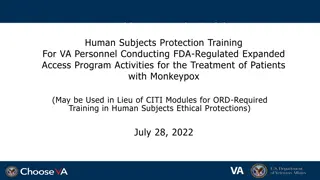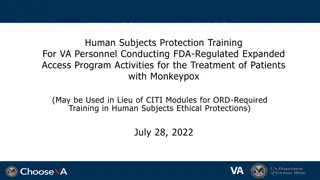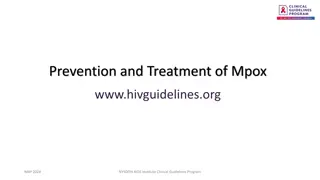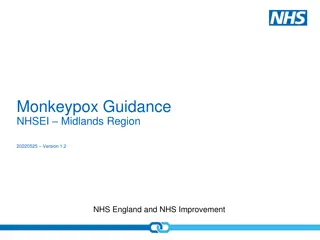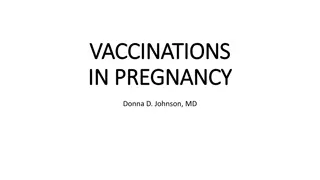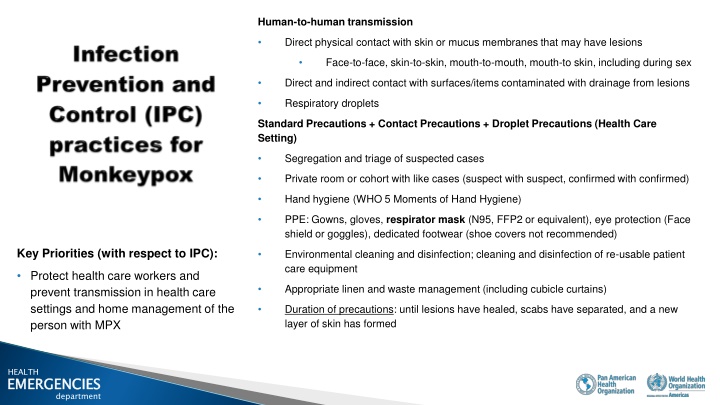
Infection Prevention and Control Measures for Human-to-Human Transmission
Learn about key infection prevention and control measures for diseases transmitted human-to-human, including direct contact and respiratory droplets. Find out how to manage cases in healthcare and home settings, providing essential care while minimizing transmission risks. Discover the importance of personal protective equipment, environmental cleaning, and proper isolation techniques. Stay informed on effective strategies to protect both patients and healthcare workers during health emergencies.
Download Presentation

Please find below an Image/Link to download the presentation.
The content on the website is provided AS IS for your information and personal use only. It may not be sold, licensed, or shared on other websites without obtaining consent from the author. If you encounter any issues during the download, it is possible that the publisher has removed the file from their server.
You are allowed to download the files provided on this website for personal or commercial use, subject to the condition that they are used lawfully. All files are the property of their respective owners.
The content on the website is provided AS IS for your information and personal use only. It may not be sold, licensed, or shared on other websites without obtaining consent from the author.
E N D
Presentation Transcript
Human-to-human transmission Direct physical contact with skin or mucus membranes that may have lesions Face-to-face, skin-to-skin, mouth-to-mouth, mouth-to skin, including during sex Direct and indirect contact with surfaces/items contaminated with drainage from lesions Respiratory droplets Standard Precautions + Contact Precautions + Droplet Precautions (Health Care Setting) Segregation and triage of suspected cases Private room or cohort with like cases (suspect with suspect, confirmed with confirmed) Hand hygiene (WHO 5 Moments of Hand Hygiene) PPE: Gowns, gloves, respirator mask (N95, FFP2 or equivalent), eye protection (Face shield or goggles), dedicated footwear (shoe covers not recommended) Key Priorities (with respect to IPC): Environmental cleaning and disinfection; cleaning and disinfection of re-usable patient care equipment Protect health care workers and prevent transmission in health care settings and home management of the person with MPX Appropriate linen and waste management (including cubicle curtains) Duration of precautions: until lesions have healed, scabs have separated, and a new layer of skin has formed HEALTH EMERGENCIES EMERGENCIES department
The patient with MPX should wear a well-fitting medical mask and cover lesions when in close proximity of others, and when moving outside of the designated isolation area (e.g. to use the toilet). If the designated person that is facilitating self- care needs to enter the isolation area, they should maintain a distance of at least 1 m from patient. Assessment of the home situation must be conducted prior to isolation at home to determine if the infection prevention and control (IPC) conditions can be fulfilled in the home setting. When distance cannot be maintained, the designated person is to wear a well-fitting medical mask and disposable gloves. The person with MPX should stay in a dedicated, well- ventilated room (e.g. with windows that can be opened frequently) separate from others in the household. They should clean their hands with either soap and water or an alcohol-based hand sanitizer, before and after contact with the patient or surrounding environment and Items such as eating utensils, linens, towels, electronic devices or beds should be dedicated to the person with MPX. Avoid sharing personal items. Perform hand hygiene before putting on and after removing their gloves. Appropriate management of contaminated linen Appropriate management of infectious waste Recommended duration of precautions: until lesions have healed, scabs have separated, and a new layer of skin has formed HEALTH EMERGENCIES EMERGENCIES department
Not stated but requires provision of IPC education for person with MPX and the designated person Provision of adequate supplies of PPE (gloves and medical masks) for person with MPX and designated person Follow-up to ensure continued supply for duration of isolation Provision of psychosocial care through a designated provider Establish method of remote monitoring Infrastructure available in the home? HEALTH EMERGENCIES EMERGENCIES department
the ability of the staff to access AND safely use PPE, following appropriate infection control procedures in potentially high-risk situations is essential. Facilities may need to provide Immediate just-in-time refresher training for staff. Most patients are being cared for in the home Pop-up trainings the health facility must be able to make resources available Assessment of the ability of the person with MPX and the designated person to maintain isolation and IPC practices in a home setting conducive to disease prevention is critical to support contact tracing to perform exposure investigations, to make rapid systems changes to support infection prevention and control, among other activities. Linens and textiles need to include cubicle curtains if persons with MPX are cohorted and spatial separation is maintained by these items HEALTH EMERGENCIES EMERGENCIES department

